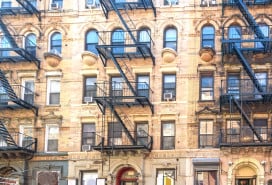Why you should prepare for noise issues when your neighbor renovates

iStock/g-stockstudio/shih-wei
You’ve been warned: Neighbors in the building will be renovating. But they’re many floors away, so surely they won't be much of a bother.
Not quite.
Though there’s enormous variation among buildings, noise might be heard in your apartment even if the renovation is on a distant floor or hallway. Floors, walls and ceilings are all attached, so structure-borne noise can reverberate through, says Alan Fierstein, owner of the noise consultancy Acoustilog.
“People are under the impression that sound goes down,” he adds. But it goes in all directions. “It isn’t subject to gravity.”
Still, once the hammering and drilling finish, the noise stops, right?
Maybe not. Kitchen and bathroom renovations, which involve plumbing changes, can cause noise that persists indefinitely. In other words, a whole new noise can be created by a neighbor’s tinkering with the pipes.
Here's why: Pipes snake throughout a building. So if a bathroom pipe starts shaking the clamp that anchors it to the wall, the rattling noise could reverberate through other apartments. If someone else’s toilet waste line touches your ceiling, the whine could reach your bedroom. If a neighbor’s new showerhead vibrates as water rushes through, you could hear the water screeching while they lather.
When installing bathroom pipes, workers bend the pipes to shoehorn them into small spaces. “All this bending may cause extra noise,” Fierstein says. Perhaps a pipe touches a wall, or a valve doesn’t fully open.
“Sometimes just the type of valve, defective or not, can create the noise,” he explains. “It is in some cases due to the pressure in the pipes. It is usually easily rectified once the problem is found, if traced to a particular bathroom.”
That’s a big if. It’s exceedingly hard to identify where a noise originates, though clues come from the timing of the renovation and the start date of the new noise.
But sometimes all it takes for a fix is moving a pipe or replacing a valve. Sometimes, too, a lack of building maintenance is an issue. Another noise source is a basement pump that runs nonstop, circulating hot and cold water. A faulty pump could cause a building-wide vibration, Fierstein says.
Modern high-rises are burdened by additional complications since they often don't have windowed bathrooms. Instead, ventilation ducts—hollow metal chambers—run vertically through the building to the roof, fed by fans that suck damp air from each bathroom they serve. Each duct feeds into many bathrooms in many units, so a rattling fan could transmit noise to all of them.
One's sensitivity to noise, of course, matters: People have vastly differing levels of tolerance. Building-noise issues can be downright injurious to New Yorkers with noise-related health conditions such as tinnitus, hyperacusis, or misophonia. Last fall, historian Michelle Marrese, who suffered from severe misophonia, committed suicide, complaining that she was unable to escape renovation noise in her Upper East Side condo.
And noise is generally less bothersome to the noisemaker than to the listener. Noise issues among neighbors are notoriously difficult to resolve; more than anything else, they keep New York’s real-estate lawyers busy.
So what’s a New Yorker to do? If you are the one renovating and you learn, via your neighbors or management company, that your renovation has resulted in persistent noise, have the contractor rework the noisy part.
If you are the suffering neighbor and the management or renovator is not responsive, there are the usual tough avenues: Keep complaining, stock up on earplugs, drown out the noise with a white noise machine, or explore soundproofing materials.





























